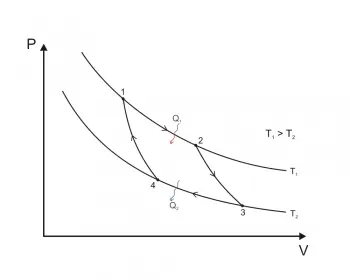
The evolution of certain magnitudes or properties concerning a certain thermodynamic system is called a thermodynamic process. These properties are called thermodynamic properties.
In order to study a thermodynamic process, it is required that the system be in thermodynamic equilibrium at the initial and final point of the process. The magnitudes that undergo a variation when passing from one state to another must be completely defined in their initial and final states. A thermodynamic system is in principle in a state of thermodynamic equilibrium when the main variables of the system remain unchanged. That is, the pressure, volume, and temperature do not remain constant over time.
A thermodynamic process can also be seen as the changes of a system, from initial conditions to other final conditions.
A thermodynamic process can be reversible or irreversible. All real transformations are irreversible since frictions cannot be completely eliminated, so the reversibility condition is only a theoretical approximation.
The theory of thermal processes is applied to the design of engines, refrigeration units, chemical industry, and meteorology.
Types of thermodynamic processes
The main thermodynamic processes are the following:
- Isobaric process: takes place at constant pressure. In other words, the system is dynamically connected, with a moving boundary, to a reservoir at constant pressure. When a perfect gas evolves isobarically from state A to state B, the associated temperature and volume follow Charles' law.
- Isochoric process: the volume remains constant. Therefore, if the system is at constant volume, the work done by the system will be zero. This implies that the process does not do pressure-volume work. It follows that any thermal energy transferred to the system externally is absorbed by it in the form of internal energy.
- Isothermal process (or isothermal process): takes place at a constant temperature. In other words, the system is thermally connected, by a thermally conductive boundary, to a constant temperature reservoir.
- Adiabatic process: It is a process in which there is no heat transfer. For a reversible process, this is identical to an isentropic process. It can be said that the system is thermally isolated from its surroundings and cannot exchange heat with the surroundings.
- Isentropic process: takes place at constant entropy. For a reversible process, this is identical to an adiabatic process.
- Process of constant chemical potential: the system is connected by particle transfer with a boundary permeable to the particles.
- Constant particle number process: No energy is added or subtracted from the system by particle transfer. It can be said that the system is isolated by the transfer of particles from its environment by a boundary permeable to the particles.
- Polytropic process: A polytropic process is a thermodynamic process during which the heat capacity of a gas remains unchanged, that is, there are no heat exchanges.
everyday examples
Below we present some everyday examples in which thermodynamic processes occur:
- Solar water heater ( isothermal process ): A solar water heater is a device that uses solar radiation to heat water. During the day, sunlight hits a solar collector, heating a fluid (such as water or antifreeze liquid) that circulates through it. This process can be considered isothermal because the temperature remains relatively constant during the absorption of solar energy.
- Cooking food ( isothermal process ): When you cook food, such as boiling water to make pasta, you are experiencing an isothermal process, where the temperature remains constant. During this process, thermal energy is transferred to the water, causing an increase in temperature and allowing the food to cook.
- Inflating a balloon ( adiabatic process ): When inflating a balloon, you are performing an adiabatic process, since it occurs without heat transfer to or from the system. The air inside the balloon is quickly compressed when inflated, which increases its temperature.
- Refrigerating food in the refrigerator ( isobaric process ): When you place hot food in the refrigerator, you are experiencing an isobaric process, where the pressure remains constant. Thermal energy is transferred from the food to the cooler environment of the refrigerator, gradually cooling it.
- Warming up the car ( isochoric process ): When starting a car on a cold day, the engine warming process can be considered isochoric, since the volume of the gases in the cylinder remains constant. The temperature increases due to the combustion of fuel.
- Using an aerosol (free expansion): When the contents of an aerosol, such as deodorant or spray paint, are released, free expansion occurs. There is no significant heat transfer during this process, and the rapid release of contents is due to the built-up pressure.


